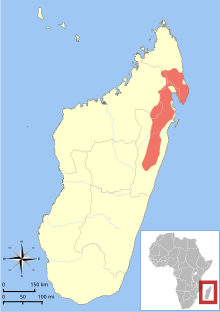Hairy-eared dwarf lemur
| Hairy-eared dwarf lemur | |
|---|---|

| |
| Scientific classification | |
| Domain: | Eukaryota |
| Kingdom: | Animalia |
| Phylum: | Chordata |
| Class: | Mammalia |
| Order: | Primates |
| Suborder: | Strepsirrhini |
| Family: | Cheirogaleidae |
| Genus: | Allocebus Petter-Rousseaux and Petter, 1967[4] |
| Species: | A. trichotis
|
| Binomial name | |
| Allocebus trichotis | |

| |
| Hairy-eared dwarf lemur range[1] | |
| Synonyms | |
|
Cheirogaleus trichotis Günther, 1875 | |
The hairy-eared dwarf lemur (Allocebus trichotis), or hairy-eared mouse lemur, is a nocturnal lemur endemic to Madagascar. It is the only member of the genus Allocebus. It was originally named by Gunter in 1875 as Cheirogaleus trichotis as part of the Cheirogaleidae family, or the dwarf lemurs. However, in 1967 the hairy-ear lemur was assigned its own genus by Petter-Rousseaux and Petter.[5] This species is likely to be critically endangered and the population is estimated at 100–1000 individuals. Field research suggests distribution of the animal seems to be patchy and restrictive and they all live in a single location in the northeastern part of the country.[1][6] Hairy-eared dwarf lemurs build leafy nests within trees to hibernate in. Their diet consists mostly of fruit, tree sap, and insects.[7]
References
- ^ a b c Template:IUCN2014.1
- ^ "Checklist of CITES Species". CITES. UNEP-WCMC. Retrieved 18 March 2015.
- ^ Günther, Albert (1875). "Notes on some Mammals from Madagascar". Proceedings of the Zoological Society of London: 78–80.
- ^ Groves, C. P. (2005). Wilson, D. E.; Reeder, D. M. (eds.). Mammal Species of the World: A Taxonomic and Geographic Reference (3rd ed.). Baltimore: Johns Hopkins University Press. p. 111. ISBN 0-801-88221-4. OCLC 62265494.
- ^ Tatterstall, Ian (1982). The Primates of Madagascar. Columbia University Press.
- ^ Mittermeier, R; Konstant, W; Hawkins, F; Louis, E; Langrand, O; Ratsimbazafy, J (2006). Lemurs of Madagascar (2nd ed). Washington DC: Conservation International.
- ^ Petter, Jean-Jacques and Desbordes, Francois. Primates of the World. Princeton University Press, 2013, p. 48.

